by P.A. Opler and W.S. Cranshaw* (6/13)
Quick Facts…
- Many kinds of butterflies can be found in Colorado. Encourage butterflies by planning a butterfly garden.
- Butterflies seek out areas with food plants for the caterpillar stage. Adult butterflies also feed on fluids such as nectar from flowers.
- Butterfly visits increase when environmental needs are met.
- Gardening practices to attract and retain butterflies often differ from regular gardening practices.
Dozens of butterfly species are commonly found along the Front Range and Eastern Colorado and are a welcome garden addition for many people. Butterflies often appear to be just passing through, occasionally stopping for a drink of nectar. You can prolong the stay of these colorful insects and draw in others by providing the food and shelter they need.
Planning the Butterfly Garden
Make a yard more attractive to butterflies by providing the proper environment, which can be food plants used by the immature stages (various caterpillars), food sources used by the adult butterflies, and physical environment.
Most butterflies prefer some shelter from the high winds common along the Front Range. At the same time, they like open, sunny areas. Windbreak plantings or other means of sheltering the butterfly garden can help provide a suitable physical environment.
Certain kinds of butterflies (mostly males) often can be seen on moist sand or mud collecting around puddles of water where they feed. The function of these “mud-puddle clubs” is not fully understood, but it is thought that the water contains dissolved minerals needed by the insects. Maintaining a damp, slightly salty area in the yard may attract groups of these butterflies.
Adult female butterflies spend time searching for food plants required by the immature caterpillar stage. Most butterflies have specific host plants on which they develop. For example, caterpillars of the monarch butterfly develop only on milkweed, while the black swallowtail feeds only on parsley, dill and closely related plants. When females find the proper host plant, they may lay eggs on it.
Providing the necessary food plants for the developing caterpillars also allows production of a “native” population that can be observed in all stages of development. Most species, however, fly away as adult butterflies.
Food for adult butterflies usually consists of sweet liquids, such as nectar from flowers, that provide energy. Some flowers contain more nectar, and are more attractive to butterflies. Often, specific types of flowers and flower colors also are more attractive. Some species feed on honeydew (produced by aphids), plant sap, rotting fruit, and even bird dung.
When planning a garden, create a large patch of a flower species to attract and retain butterflies. Consider flowers that bloom in sequence. This is particularly important during summer when flower visiting by butterflies is most frequent. Flowers and flowering shrubs that might be good choices for an Eastern Colorado butterfly garden are included in Table 1.
| Table 1: Some nectar-bearing plants commonly visited by butterflies. | |
| Asters (Aster spp.) Bee balm (Monarda) Butterfly bush (Buddleia davidii)Butterfly plant (Asclepias tuberosa) Bush cinquefolia (Potentilla fruticosa) Cosmos (Cosmos spp.) Gaillardia (Gaillardia spp.) Lilac (Syringa vulgaris) |
Marigold (Tagetes spp.) Ornamental thistlesRabbitbrush (Chrysothamnus nauseosus) Sunflower (Helianthus spp.) Sweet pea (Lathyrus odoratus) |
Common butterflies in Eastern Colorado and the foods they prefer are shown in Table 2. Include these food sources to encourage a steady flow of butterfly visitors.
Common Conflicts
Many of the most attractive nectar plants are commonly considered as “weeds” in other settings. Good examples are various thistles and dandelion, all highly attractive to several common butterflies. The well-manicured and tended garden discourages some butterfly species that develop on wild types of plants. (Note: Canada thistle is considered a noxious weed. Areas that have formed weed districts prohibit by law the culture of Canada thistle.)
A few butterflies also develop on certain garden crops and may be pests if the vegetable is considered more desirable than the insects. The European cabbage butterfly (on broccoli, cabbage and other mustards) and the black swallowtail (on parsley and dill) are common garden inhabitants in Colorado.
Use insecticides sparingly because most are not compatible with attracting and increasing the number of butterflies in a yard. Most garden insecticides can kill the caterpillar stages of the insects. Adult butterflies also can be killed by resting on insecticide-treated surfaces.
| Table 2: Food used by common Eastern Colorado butterflies and skippers. | |||
| Butterfly | Flight period | Caterpillar food | Common nectar plants, adult food |
|---|---|---|---|
| Black swallowtail (Papilio polyxenes) |
April-September | Dill, parsley, fennel, carrot | Butterfly weed, alfalfa, thistle |
| Checkered skipper (Pyrgus communis) |
April-October | Mallow, hollyhock | Verbena, dandelion, Canada thistle, aster |
| Checkered white (Pontia protodice) |
April-November | Tumble mustard | Alfafa, mustards, bee balm |
| Clouded sulfur (Colias philodice) |
April-November | Alfalfa, clover | Alfalfa, phlox, rabbitbrush, aster, marigold |
| Edwards fritillary (Speyeria edwardsii) |
June-September | Nuttall’s violet | Rabbitbrush, gaillardia, bee balm |
| European cabbage butterfly (Pieris rapae) |
April-October | Broccoli, cabbage (mustard family) | Many |
| Gorgone checkerspot (Charidryas gorgone) |
May-September | Sunflowers | White clover, dandelion, Canada thistle |
| Gray hairstreak (Strymon melinus) |
May-October | Many | Many |
| Hackberry butterfly (Asterocampa celtis) |
May-September | Hackberry | Rotting fruit, sap flows |
| Melissa blue (Lycaeides melissa) |
April-October | Wild licorice, alfalfa, etc. | Bee balm, sweet clover |
| Monarch (Danaus plexippus) |
June-October | Milkweed | Cosmos, Canada thistle, rabbitbrush, etc. |
| Mourning cloak (Nymphalis antiopa) |
February-November | Willow, aspen, cottonwood, elm | Rabbitbrush, milkweed, sap |
| Orange sulfur (Colias eurytheme) |
April-October | Alfalfa, vetch, pea | Alfalfa, marigold, zinnia |
| Painted Lady (Vanessa cardui) |
April-October | Thistle, hollyhock, sunflower | Grape hyacinth, cosmos, zinnia, alfalfa, many flowers |
| Silver-spotted skipper (Epargyreus clarus) |
May-July | Wild licorice, locust, etc. | Lilac, dogbane, zinnia, sweet pea, Canada thistle |
| Two-tailed swallowtail (Papilio multicaudatus) |
April-August | Green ash, chokecherry | Geranium, thistle, milkweed |
| Variegated fritillary (Euptoieta claudia) |
April-October | Various, including pansy | Rabbitbrush, Canada thistle |
| Weidemeyer’s admiral (Limentitis weidemeyerii) |
June-September | Willow, aspen, cottonwood | Sap flows, snowberry, dung |
| Western tiger swallowtail(Papilio rutulus) | May-July | Willow, cottonwood, chokecherry | Zinnia, lilac, butterflybush, thistle, milkweed |
| Wood nymph (Cercyonis pegala) |
June-August | Grasses | Rabbitbrush, clematis, Canada thistle |
Some Common Colorado Butterflies |
||
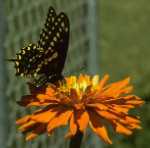 |
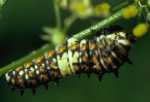 |
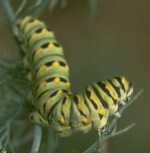 |
Figure 1: Black swallowtail. |
Figure 2: Black swallowtail larvae. Early instar (left), later instar (right). |
|
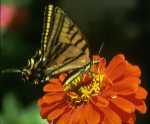 |
 |
 |
Figure 3: Two-tailed swallowtail. |
Figure 4: Two-tailed swallowtail larvae. Early instar (left), later instar (right). |
|
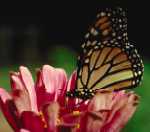 |
 |
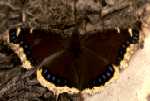 |
Figure 5: Monarch. |
Figure 6: Monarch larva. |
Figure 7: Mourning cloak. |
 |
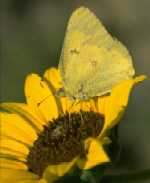 |
 |
Figure 8: Mourning cloak larva. |
Figure 9: Common sulphur. |
Figure 10: Common sulphur larva. |
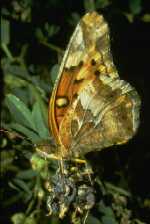 |
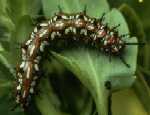 |
|
Figure 11: Variegated fritillary. |
Figure 12: Variegated fritillary larva. |
|
References
- A Field Guide to Western Butterflies, 2nd Edition. 1999. P.A. Opler and A. Wright (illustrator). Peterson Field Guide Series, Houghton-Mifflin.
- Butterflies of North America. P.A. Opler, R.E. Stanford, H. Pavulaan, coordinators, USDI-USGS, Northern Prairie Wildlife Research Center. http://www.npwrc.usgs.gov/resource/distr/lepid/bflyusa/bflyusa.htm
- Butterfly Gardening: Creating Summer Magic in Your Garden. 1990. Xerces Society, in association with the Smithsonian Institution. Sierra Club Books. San Francisco.
- Emmel, T.C., M.C. Minno and B.A. Drummond. 1992. Florissant Butterflies: A Guide to the Fossil and Present Day Species of Central Colorado. Stanford University Press. Stanford, Calif.
- Ferris, C.D., and F.M. Brown. 1981. Butterflies of the Rocky Mountain States. University of Oklahoma Press. Norman, Okla.
- Opler, P., and S.W. Strawn. 1988. Butterflies of the American West: A Coloring Album. Roberts Rinehart. Niwot, Colo.
- Opler, P., and A.B. Wright. 1994. Peterson First Guides. Butterflies and Moths. Houghton Mifflin. Boston, New York.
- Pyle, R.M. 1981. Audubon Field Guide to North American Butterflies. Alfred A. Knopf. New York.
1P.A. Opler, Geological Survey, U.S. Department of the Interior; and W.S. Cranshaw, Colorado State University Extension entomologist and professor, bioagricultural sciences and pest management. 4/96. Revised 6/13.
Go to top of this page.





